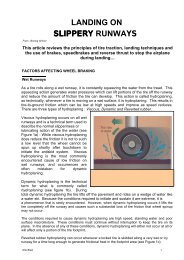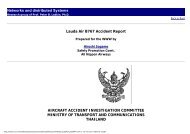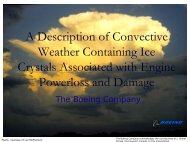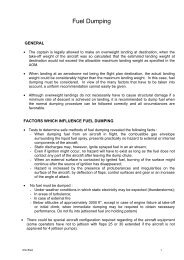Boeing 737-236 series 1, G-BGJL: Main document - Leonardo
Boeing 737-236 series 1, G-BGJL: Main document - Leonardo
Boeing 737-236 series 1, G-BGJL: Main document - Leonardo
You also want an ePaper? Increase the reach of your titles
YUMPU automatically turns print PDFs into web optimized ePapers that Google loves.
Burns produced by hydrofluoric acid produce throbbing pain andprogressive destruction of tissues<br />
with decalcification and necrosisof bone. Combustion of fluorinated polymers may also produce<br />
saturatedand unsaturated fluorinated hydrocarbons of low molecular weight,which are also<br />
extremely toxic.<br />
Hydrogen Chloride (HCl)<br />
Combustion of PVC and many fire-retardant materials produces hydrogenchloride. Hydrogen<br />
chloride combines with water to form hydrochloricacid which has a highly irritant effect on the<br />
throat and respiratorytracts, causing destructive damage to the mucous membranes andpulmonary<br />
oedema. It is an intense irritant to the eyes, throatand respiratory tracts, causing destructive damage<br />
to the mucousmembranes and pulmonary oedema.<br />
Sulphur Dioxide (SO2)<br />
This gas is produced on combustion of both natural and syntheticrubbers and other compounds<br />
containing sulphur. It combines withmoisture to produce sulphurous acid which is highly irritant<br />
totissue, including the eyes. It attacks the mucous membranes ofthe respiratory tract, causing<br />
uncontrollable coughing. Very highconcentrations can induce respiratory paralysis.<br />
Ammonia (NH3)<br />
This gas is produced upon combustion of polyurethane, polyamides,polyacrylonitrile, silk and<br />
wood. It is a highly irritant causticand has a violent affect upon the respiratory tract and eyes.It<br />
inhibits respiration and in high concentrations may cause cardiac-arrestvia the respiratory reflexes.<br />
It produces bronchial constrictionand pulmonary oedema.<br />
Acrolein (CH2 CH CHO)<br />
Acrolein is one of the most irritant of the aldehydes producedby the combustion of cabin materials.<br />
It is also produced in smallamounts from burning kerosene and from the combustion of<br />
naturalmaterials such as wood and cotton. It is an intense eye irritantand in concentrations as low as<br />
5.5 ppm has been shown by Deichmannand Gerarde2 to cause irritation of the upper respiratory<br />
tract.At higher concentrations, pulmonary oedema occurs, with deathafter a few minutes at only l0<br />
ppm.<br />
Aromatic hydrocarbons (eg Benzene, Toluene, Styrene etc)<br />
A whole range of aromatic compounds are produced by the thermaldegradation of synthetic (and<br />
natural) materials. They producevarying degrees of narcosis. Several of these aromatics such<br />
asbenzene (from PVC) are not only absorbed due to inhalation, butcan also be absorbed directly<br />
through the skin. Concentrationsof l00 ppm are considered injurious to health. Toluene is lesstoxic<br />
than benzene but, conversely, represents a greater dangerin chronic exposure.<br />
Styrene is considered safe at concentrations less than l00 ppm,but above this is highly irritant to the<br />
mucous membranes, causingsymptoms of toxicity with impairment of the neurological functions.In<br />
concentrations of approximately 800 ppm, it causes 'styrenedisease', characterised by nausea,<br />
vomiting and total weakness.<br />
Aliphatic hydrocarbons<br />
Thermal degradation of all organic materials produces a varietyof aliphatic compounds. Some of<br />
these compounds with the lowermolecular weights can produce narcosis. Unsaturated
















